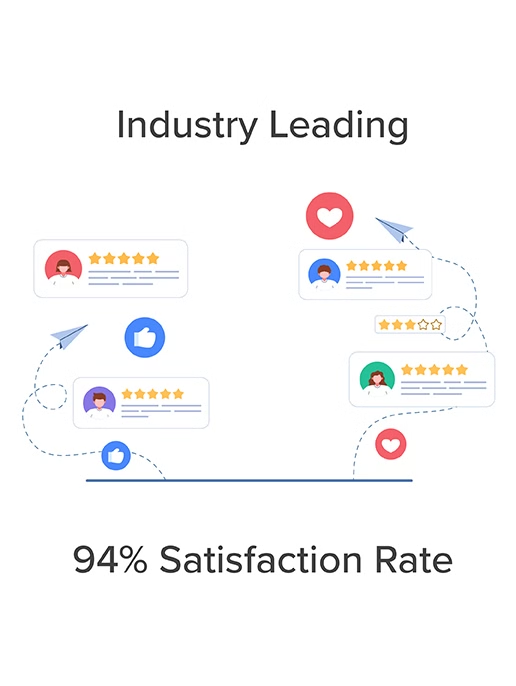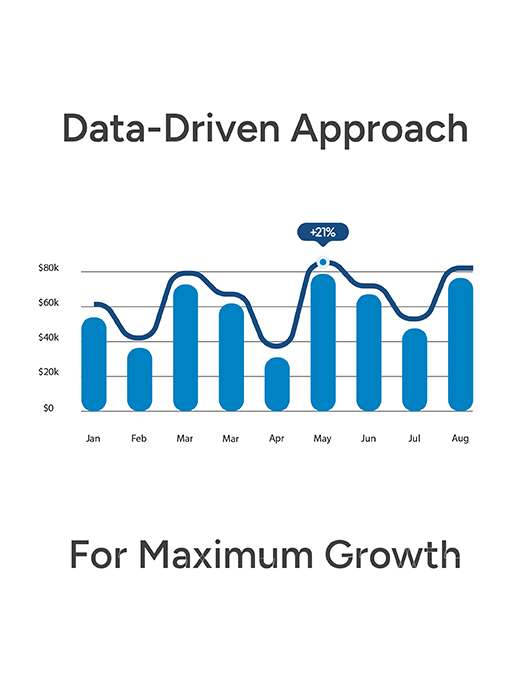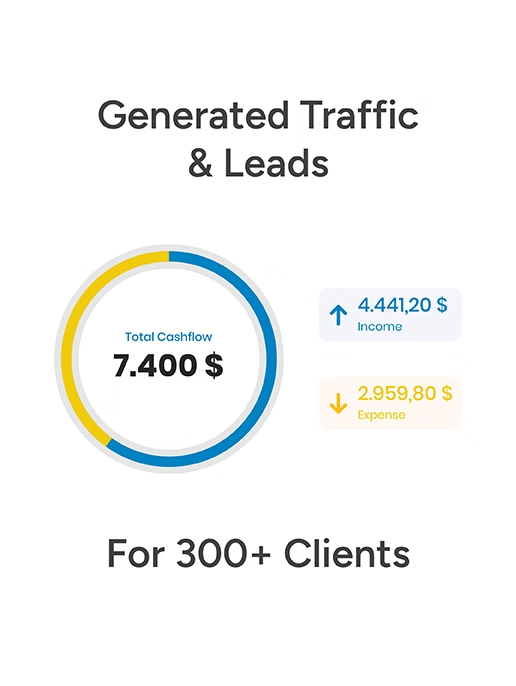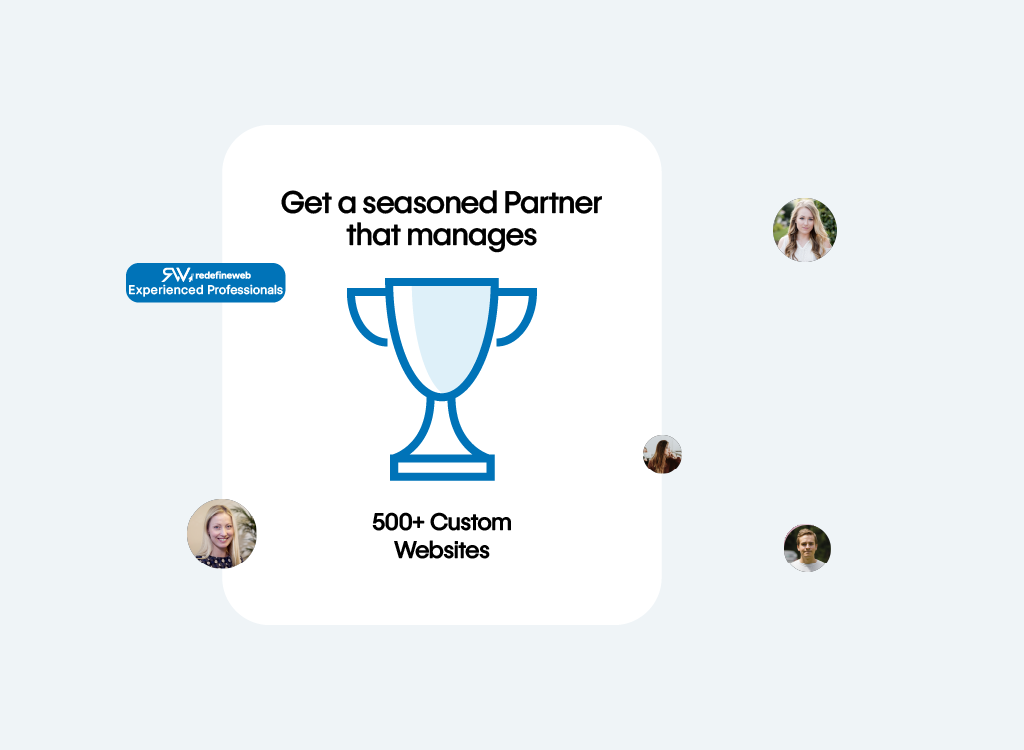


A professional web development agency typically charges between $4,000 and $10,000 to create a custom website for a consulting practice. For many consultants, that cost can strain budgets and limit investment in client acquisition and marketing.
Instead, choose one of our consultant website packages and get started with a free starter website. We’ve designed these plans to overcome the common hurdles consultants face online—such as building credibility, showcasing expertise, optimizing for search visibility, and generating qualified leads.
With our comprehensive website packages, we handle the technical details—design, development, SEO, and content—so you can focus on what you do best: delivering results and advising your clients.

A professional online presence is essential for any consultant looking to build credibility and attract clients. However, even the simplest website builder can take hours before you’re ready to launch a site that truly represents your expertise.
At Redefine Web, we provide all-inclusive website solutions designed specifically for consultants. From design and development to SEO and marketing, we handle everything so you can focus on your clients and your practice.
We work closely with you to understand your consulting niche, audience, and goals—crafting a website that highlights your expertise and sets you apart in your industry. This comprehensive approach helps you strengthen your reputation, reach new clients, and grow your consulting business.

| Feature | Essential | Growth | Business | Custom |
|---|---|---|---|---|
| Design/Retainer Hours | 5 Hours (One-time) | |||
| Security Patches | ✓ | ✓ | ✓ | ✓ |
| Full-site backup | Monthly | Weekly | Weekly | ✓ |
| Security Scan | Monthly | Weekly | Weekly | ✓ |
| Server Migration | ✓ | ✓ | ✓ | ✓ |
| Copywriting | ✓ | ✓ | ✓ | ✓ |
| Keyword Research | ✓ | ✓ | ✓ | ✓ |
| Blog Posts | ✓ | 1 | 1 | 1 |
| Text Updates | ✓ | ✓ | ✓ | ✓ |
| On-page SEO | ✓ | ✓ | ✓ | ✓ |
| Photos Update | ✓ | ✓ | ✓ | ✓ |
| Off-page SEO |
| Feature | Essential | Growth | Business | Custom |
|---|---|---|---|---|
| Server Side Caching | ✓ | ✓ | ✓ | ✓ |
| HTTP Protocol | ✓ | ✓ | ✓ | ✓ |
| OpCache | ✓ | ✓ | ✓ | ✓ |
| Mod_Expires | ✓ | ✓ | ✓ | ✓ |
| Browser Cache | ✓ | ✓ | ✓ | ✓ |
| Brotli Compression | ✓ | ✓ | ✓ | ✓ |
| CDN | 82 POPs | 82 POPs | 82 POPs | 82 POPs |
| Feature | Essential | Growth | Business | Custom |
| Email Forwarders | ✓ | ✓ | ✓ | ✓ |
| Catch-all Emails | ✓ | ✓ | ✓ | ✓ |
| Email Aliases | ✓ | ✓ | ✓ | ✓ |
| IMAP/POP3/SMTP | ✓ | ✓ | ✓ | ✓ |
| Autoresponders | ✓ | ✓ | ✓ | ✓ |
| Filters | ✓ | ✓ | ✓ | ✓ |
| MX/SPF/DKIM Records | ✓ | ✓ | ✓ | ✓ |
| Email Virus Scanner | ✓ | ✓ | ✓ | ✓ |
| Feature | Essential | Growth | Business | Custom |
|---|---|---|---|---|
| Design/Retainer Hours | 5 Hours (One-time) | |||
| Security Patches | ✓ | ✓ | ✓ | ✓ |
| Full-site backup | Monthly | Weekly | Weekly | ✓ |
| Security Scan | Monthly | Weekly | Weekly | ✓ |
| Server Migration | ✓ | ✓ | ✓ | ✓ |
| Copywriting | ✓ | ✓ | ✓ | ✓ |
| Keyword Research | ✓ | ✓ | ✓ | ✓ |
| Blog Posts | ✓ | 1 | 1 | 1 |
| Text Updates | ✓ | ✓ | ✓ | ✓ |
| On-page SEO | ✓ | ✓ | ✓ | ✓ |
| Photos Update | ✓ | ✓ | ✓ | ✓ |
| Off-page SEO |
We often send out our newsletter with news and great offers. We will never disclose your data to third parties and you can unsubscribe from the newsletter at any time.
Unfortunately, we’re unable to offer free samples. As a retailer, we buy all magazines from their publishers at the regular trade price. However, you could contact the magazine’s publisher directly to ask if they can send you a free copy.
You can create a new account at the end of the order process or on the following page. You can view all of your orders and subscriptions in your customer account. You can also change your addresses and your password.
No, you don’t have to create an account. But there are a few advantages if you create an account.
You never have to enter your billing and shipping address again
Find all of your orders, subscriptions and addresses in your account
Download invoices of your orders
No, we don’t have a physical store location at the moment. We accept only orders through our online shop and we’re shipping all orders with the Swiss Post Service. Please visit our shipping section for more details.
From time to time you will find us at design fairs and popup markets in Switzerland. Subscribe to our newsletter and you’ll receive the latest news.
To ensure every client experiences fast, reliable performance, we set a soft traffic limit that easily supports the average consulting business. If your website begins attracting more visitors—a strong sign your marketing is working—we’ll help you seamlessly upgrade to a plan with more capacity, faster load speeds, and advanced marketing tools so you can keep expanding without interruptions.
Each paid plan includes professional, domain-based email addresses (e.g., info@yourfirm.com, contact@yourname.com) to give your business a trustworthy, client-ready look. You can set up emails for inquiries, client communications, or billing—helping you stay organized and present a unified, professional image.
Each consulting website package comes with dedicated design hours to personalize your site. During these hours, our design team customizes your chosen layout to match your brand identity, expertise, and target audience. From color adjustments to structural enhancements and visuals, we make sure your website accurately represents your professionalism. Need more advanced features such as booking pages or lead capture forms? Additional design hours are easy to add.
We use your included design hours to create a site that looks polished, on-brand, and optimized for client engagement. Our designers focus on clarity, credibility, and conversion—ensuring your website not only looks great but helps turn visitors into leads. If you ever need future updates or expanded layouts, you can simply add more hours as your business grows.
Yes. If you’d like full ownership of your consulting website and prefer to handle hosting independently, our buyout option gives you complete control. We provide all design files, content assets, and step-by-step instructions to ensure a smooth transition—allowing your business to grow entirely on your terms.
Most consulting websites are completed within 30 days, depending on how quickly branding materials, photos, and content are provided. Advanced projects—such as those with booking systems, gated content, or custom dashboards—may take a bit longer. You’ll receive a clear delivery timeline upfront before any work begins.
Yes, you’ll need to provide your copy and photos. However, if you’d like help crafting compelling messaging, our SEO copywriting team can write persuasive, search-optimized content that positions you as the authority in your field and attracts qualified leads.
Absolutely. Every consultant and coach has unique goals. You can choose from powerful add-ons like Local SEO, Google Ads management, lead magnet development, or custom landing pages for specific services. You can scale or add new features anytime as your consulting business grows.
Absolutely. Every consultant and coach has unique goals. You can choose from powerful add-ons like Local SEO, Google Ads management, lead magnet development, or custom landing pages for specific services. You can scale or add new features anytime as your consulting business grows.
We guarantee 99.9% uptime, so your consulting website is always available when potential clients are researching or ready to connect. Every plan includes SSL encryption, malware protection, and 24/7 site monitoring for secure, uninterrupted performance—at no additional cost.
Heat mapping analyzes how visitors interact with your site—where they click, scroll, and spend the most time. For consultants, this helps identify your most engaging content, pages, or calls to action. We then use this data to fine-tune your site for higher engagement and stronger lead generation.
UX (User Experience) analysis focuses on how easily visitors navigate your site. We study flow, structure, and usability to identify opportunities for improvement. When potential clients can quickly understand your services and take action, conversion rates and SEO rankings rise—making your website a more effective sales tool.
Our performance optimization ensures your consulting website loads quickly and runs seamlessly on all devices. A fast website improves credibility, reduces bounce rates, and can boost your Google rankings. We continuously monitor and fine-tune site speed and code quality so your visitors enjoy a smooth, professional experience every time.
You’ll have a dedicated account manager and access to a client portal for easy communication, progress updates, and support requests. If you’re running digital marketing campaigns, we’ll schedule strategy calls to review reports, discuss next steps, and refine your approach for better results month after month.
Our free Google Ads audit for consultants reviews your campaigns to uncover ways to improve ROI and generate higher-quality leads. Once granted read-only access, we will:
You’ll receive an actionable report that outlines how to refine your campaigns, attract better clients, and get the most value from your ad investment.
Optimization focuses on improving your consulting website’s performance and speed. This includes tasks like cleaning up code, compressing images, and enabling caching to ensure your site loads quickly and provides a seamless experience for visitors exploring your services.
Maintenance, on the other hand, focuses on stability and protection. It includes updating plugins, themes, and core systems, plus monitoring security and fixing technical issues—all to keep your site functional, secure, and worry-free.
In short: optimization enhances the client experience, while maintenance keeps your website safe, stable, and performing at its best.
Our maintenance services are designed to ensure your website runs fast, securely, and consistently. We refine your code, optimize your images and contact forms, and monitor performance across all devices. This makes it easier for potential clients to find key information, submit inquiries, and book consultations without any delays.
We handle technical updates, fix issues proactively, and oversee ongoing performance—so your website stays reliable while you stay focused on helping your clients.
Core Web Vitals measure speed, responsiveness, and visual stability—key indicators of a smooth browsing experience.
For consultants and coaches, a strong Core Web Vitals score helps your site rank higher on Google, keeps prospects engaged, and builds trust by creating a professional, friction-free browsing experience. In other words, a fast and stable site means more clients stay long enough to take action.
Communication is a core part of our process. You’ll have access to our online project management system, providing transparent updates on progress and timelines. Depending on your plan, you’ll also have a dedicated project manager to answer questions, gather feedback, and keep your build on schedule.
After launch, you’ll gain access to your client dashboard for support requests and updates. If you’ve added services like PPC or SEO, your account manager will schedule regular strategy sessions to review performance and refine campaigns for better client acquisition.
Your consulting website will be protected by enterprise-grade security systems powered by CloudLinux and Imunify360. These tools defend against malware, hacking, and unauthorized access.
We also conduct regular vulnerability scans, secure all forms where clients submit data, and use QUIC.Cloud’s CDN with Layer-7 DDoS protection for lightning-fast, safe browsing. Our infrastructure ensures your site—and your reputation—stay secure, compliant, and resilient against emerging threats.
Yes. We’ll manage the entire migration process for you. Our team transfers your website’s content, database, and images to our optimized platform smoothly and securely, maintaining all your SEO structure and performance.
Your site will not only remain consistent during migration but will also run faster, safer, and more efficiently after the move.
Absolutely. Every plan includes automated, off-site backups stored in secure data centers. In rare cases of technical issues or unexpected outages, we can quickly restore your site to full operation. That means no lost inquiries, no downtime, and no disruption to your client acquisition process.
All updates and patches go through a rigorous process. We test every change within a staging environment to ensure that layouts, contact forms, and integrations continue running perfectly.
Once validated, updates are deployed safely to your live site without disruption. Even our base plans include continuous monitoring, proactive updates, and testing protocols so your website stays secure and up to date at all times.
None at all. Backup restoration is always included in your plan. If an issue ever arises during an update or a plugin conflict, we’ll restore your site right away—so your contact forms, booking tools, and testimonials stay visible and functional without downtime or extra fees.
We take a comprehensive, multi-layered approach to security. Our servers employ advanced firewalls, intrusion detection, and malware scanning systems to stop threats before they ever reach your site.
We also use QUIC.Cloud’s CDN with Layer-7 DDoS protection for both speed and defense. Security patches are applied immediately once released, ensuring your consulting website remains protected, professional, and always online—24/7.
Yes! Our SEO and PPC management services are built to help consultants, coaches, and advisory firms attract qualified clients and appear at the top of Google when people search for your expertise.
A professional website builds trust — but visibility drives growth. Our SEO strategy focuses on high-converting keywords like “business consultant in [city]” or “executive coach near me.” We handle everything from keyword research to on-page optimization and link-building.
Since SEO builds momentum over time, we often combine it with PPC (paid ads) to place your consulting firm instantly in front of ready-to-hire clients. Together, these services generate consistent inquiries and drive measurable business growth.
We begin by understanding your firm — your niche, services, and ideal clients. Using advanced tools like SEMrush and Google Keyword Planner, we identify high-performing, intent-driven keywords such as “leadership consultant in [city]” or “small business coaching.”
From there, we weave these keywords naturally throughout your site content, service pages, and metadata. The result: higher rankings, more targeted traffic, and more inquiries from people who are actively looking for your expertise.
We meticulously fine-tune every on-page element of your consulting website. That includes optimizing page titles, meta descriptions, headings, image alt tags, and internal linking for stronger rankings and better user experience.
Your site will be structured for clarity, speed, and engagement — helping potential clients quickly find your services, understand your value, and take action while reinforcing your authority with search engines.
Our team creates polished, professional content that builds trust and positions you as an authority. We research your audience, services, and competitors to craft clear, persuasive pages covering topics such as business strategy, leadership training, or executive coaching.
Each page follows SEO best practices to help your site rank better and attract qualified leads while keeping visitors informed and confident in what you offer.
Yes. Local SEO is especially important if you offer consulting services to clients in specific locations. We optimize your Google Business Profile, manage directory listings, and help generate authentic client reviews — all designed to increase your visibility in local and industry-specific searches.
The outcome? When potential clients search for expert help nearby, you’re the top name they see and trust.
Transparency is key. You’ll receive regular, easy-to-read reports showing your keyword rankings, traffic, lead submissions, and call inquiries. For PPC, we include performance data such as cost per lead, ROI, and conversion rates.
Your dedicated account manager will walk you through the metrics, highlight improvements, and adjust strategies to make sure your campaigns continuously deliver growth and strong returns.
We offer flexible, customizable packages based on your goals and budget. SEO plans can include keyword optimization, blog content, local citations, and technical audits. PPC management costs are based on ad spend and campaign scope — always with full transparency.
You’ll always know where your investment is going, and even better — how it’s working to bring more leads and stronger revenue to your business.
Most clients start seeing noticeable improvements in traffic, rankings, and lead flow within three to six months, depending on your competition and market size. SEO is a long-term strategy — the longer it runs, the stronger your results become, compounding over time into sustained client growth.
Our pay-per-click campaigns are custom-built for the consulting industry. We target high-conversion search terms like “leadership development consultant in [city]” or “business growth advisory.”
We carefully craft ad copy that speaks to your audience’s pain points and positions your services as the solution. Each campaign is continuously optimized to lower costs, improve click-through rates, and deliver high-value prospects ready to work with you.
We narrow down your audience based on industry, location, client intent, company size, and search behavior — ensuring your ads reach people who are most likely to hire you.
We also set up remarketing campaigns to re-engage visitors who’ve shown interest but haven’t yet reached out. With consistent tracking and optimization, we refine performance to decrease your acquisition cost and bring in the types of clients you really want.
Getting started is simple. Choose a consulting website package and share your key business details — your logo, services, niche, and any design preferences. Once we have what we need, our team handles everything from setup to launch, creating a website that helps potential clients discover, learn about, and connect with you online. Prefer a done‑for‑you experience? Our SEO copywriting add‑on covers all the content creation for you.
Yes! Every consulting website we build includes an intuitive content management system. You or your team can easily update service pages, blog posts, case studies, testimonials, or images—no technical experience required.
Our plans include secure, high‑speed hosting optimized for consulting websites. If you’d rather manage hosting on your own, you can transfer your site anytime after a one‑time buyout fee. However, we recommend keeping your hosting with us to maintain maximum performance, strong security, and full technical support.
Absolutely. Your staff can log in anytime to upload new blog posts, client success stories, or educational resources. It’s quick and easy to manage internally. If you’d rather focus on your work, our content‑writing team can provide ongoing SEO‑optimized updates for you.
Our hosting plans are designed to scale with your success. The base package easily supports up to 10,000 visits per month, perfect for small to mid‑sized consulting businesses. As your audience grows, we’ll seamlessly upgrade your plan to maintain top‑tier performance, so your site stays fast, secure, and reliable.
Yes. Every consulting website is built with SEO best practices from day one. We focus on fast loading times, mobile responsiveness, and clear site structure to help you rank higher in local and industry searches. To take it even further, our SEO add‑on targets the specific keywords your ideal clients are searching for—helping your site attract more qualified leads.
A design hour is dedicated time our design experts spend customizing your site. During these hours, we personalize visuals, colors, and layouts to reflect your brand identity and professional image. Our standard plan includes four design hours—plenty for a polished, distinctive look. You can always add more hours for advanced customization or new features.
You’re welcome to provide your own copy and imagery, but if you prefer, our copywriting team can create persuasive, keyword‑optimized content tailored for your consulting audience. This ensures your site showcases your expertise and converts visitors into clients more effectively.
Absolutely. Each dental practice has unique needs. Whether you want advanced design, more pages, or integrated appointment booking features, we can provide a custom quote tailored to your goals and budget.
Our managed hosting takes the headache out of maintaining your consulting website—so you can focus entirely on clients, not technology. You’ll access over 500 ready-to-build templates, including designs ideal for professional consultants and coaches. Each plan includes four hours of design customization to integrate your branding, logo, and content, letting you launch quickly with a polished, credible image.
Every hosting package includes secure off-site backups, and 24/7 server monitoring. We handle updates, speed optimization, and security—giving your consulting business a reliable online foundation and lasting peace of mind.
As your client base expands and your traffic increases, our hosting scales effortlessly with you. If your site exceeds 10,000 visits per month, we’ll upgrade your plan with no downtime.
You can also expand your services anytime—add-ons like SEO-optimized content, Google Ads management, or email automation help keep your business visibility growing as your consulting practice scales. Whether you’re an independent consultant or building a multi-advisor firm, our hosting supports smooth growth every step of the way.
We make security a top priority. Our servers are protected by enterprise-level firewalls, intrusion detection, and routine updates designed for business-grade data protection. With real-time monitoring and automated backups stored in secure off-site data centers, your consulting website remains safe, compliant, and recoverable at any time—protecting both your information and your clients’ trust.
Yes. We can migrate your current consulting website to our hosting platform quickly and safely, with little to no downtime. Our team transfers all your pages, settings, and data seamlessly—keeping your SEO rankings intact while improving performance, reliability, and security.
If your site traffic exceeds 10,000 monthly visits, we’ll proactively reach out to discuss an upgrade that ensures continued performance. The process is seamless—no downtime, no hidden charges. Occasional spikes won’t trigger fees; our flexible hosting adjusts to keep up with your growing success.
Our data centers are located across North America and Europe. We’ll host your consulting website on the nearest server to your primary market, ensuring faster page loads and a smoother browsing experience for your clients and visitors.
Absolutely. We tailor every hosting package around your consulting firm’s specific needs—whether that means more bandwidth, advanced security, additional storage, or faster load speeds. As your business evolves, your plan evolves with it—keeping your website running smoothly and professionally at every stage of growth.
Yes. If your consulting website is already built, we can host it for you. You’ll enjoy high speed, powerful security, and daily backups managed by our technical team. It’s the perfect choice for consultants who want dependable, hands-free hosting without design or marketing services.
Yes. Monthly subscribers can export content after one year, and annual plan holders can export anytime. If you decide to switch hosting providers, we’ll coordinate the transfer carefully to prevent downtime and keep your website accessible throughout the move.
Buyout fees depend on the level of customization completed for your consulting site. We provide a transparent, itemized quote so you can make an informed decision. The goal is to ensure you have total ownership, flexibility, and freedom to manage your online presence however you choose.
